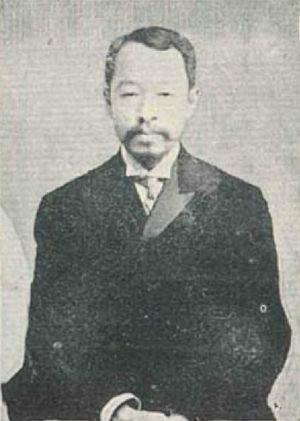Park Yung-hyo
This article may be expanded with text translated from the corresponding article in Korean. (July 2017) Click [show] for important translation instructions.
|
Park Yung-hyo | |||||||||||||||||||||||||||||||||||
|---|---|---|---|---|---|---|---|---|---|---|---|---|---|---|---|---|---|---|---|---|---|---|---|---|---|---|---|---|---|---|---|---|---|---|---|
 | |||||||||||||||||||||||||||||||||||
| Prime Minister of Joseon | |||||||||||||||||||||||||||||||||||
| In office May 21, 1895 – May 31, 1895 | |||||||||||||||||||||||||||||||||||
| Monarch | Gojong | ||||||||||||||||||||||||||||||||||
| Preceded by | Kim Hong-jip | ||||||||||||||||||||||||||||||||||
| Succeeded by | Bak Jeongyang | ||||||||||||||||||||||||||||||||||
| Personal details | |||||||||||||||||||||||||||||||||||
| Born | 1861 Suwon, Kingdom of Joseon | ||||||||||||||||||||||||||||||||||
| Died | 21 September 1939 (aged 78) Keijo, Japanese Korea | ||||||||||||||||||||||||||||||||||
| |||||||||||||||||||||||||||||||||||
Park Yung-hyo or Bak Young-hyo (Korean: 박영효; Hanja: 朴泳孝; 1861 – 21 September 1939) was a Korean politician from the Joseon Dynasty, an enlightenment activist, diplomat and pro-Japanese collaborator. He was one of the organizers of the Gapsin Coup of 1884, in which progressive political elements attempted to overthrow the conservative Korean government. He become Prince Consort Geumneung through his marriage to Princess Yeonghye, King Cheoljong's daughter.
Early life and education
Park Yung-hyo was born in Suwon, south of Hanseong. He was the third son of Park Won-yang and his mother was Lady Yi of the Jeonui Yi clan. By birth, he also had a distant connection with the Royal Family: his 7-great-grandfather was Park Se-gyo (朴世橋, 박세교; 1611 – 1663), the only son of King Seonjo's 5th daughter, Princess Jeongan (정안 옹주; 1590 – 1660), and Park Mi, Prince Consort Geumyang (박미 금양위, 朴瀰 錦陽尉; 1592 – 1645).
On April 3, 1872, he was chosen to be the spouse of Princess Yeonghye (영혜옹주; 永惠翁主), the only living daughter of King Cheoljong, the 25th King of the Joseon Dynasty. However, the princess passed away merely three months after their wedding.
Together with Kim Ok-gyun, Park was a strong supporter of the Dongnipdang, or “Enlightenment Party”, which sought to reform the government, economy, and military by incorporating Western technology and methodology, so that Korea would become stable enough to withstand increasing foreign encroachment. He accompanied Kim on his visit to Tokyo, meeting with various influential Japanese politicians, including Fukuzawa Yukichi.
Career
He is credited with creating the first Korean national flag, in 1882.[1]
Gapsin Coup
Park was one of the leaders of the 1884 Gapsin Coup that attempted to overthrow the government and institute Western-style reforms. The coup attempt lasted only three days before its suppression by Chinese troops. He was forced to flee to Japan, where he initially stayed with Fukuzawa Yukichi, before moving on to Kobe.
Subsequent career
Park served briefly as Minister of the Interior and Prime Minister in 1895, playing an important role in opening up Korea. However, following the Gabo Reform and the assassination of Queen Min, Park fled to Japan once again, where he remained until 1907. On his return, he accepted the post of Royal Household Minister under Yi Wan-yong.
Following the Japan-Korea Treaty of 1910, in which Korea was annexed to the Empire of Japan, Park was awarded with the kazoku title of marquess (koshaku) in the Japanese peerage, and a seat in the House of Peers in the Diet of Japan. He served as Director of the Bank of Chosen in 1918, Chairman of the Korean Economic Association in 1919, first president of The Dong-a Ilbo newspaper in 1920, president of the Kyungbang Corporation, chairman of the Korea Industrialization Bank in 1921, and advisor to the Government-General of Korea’s Central Institute.
Family
Among Park's granddaughters was Park Chan-ju (박찬주, 朴贊珠) (11 December 1914 – 13 July 1995), who was the mother of Yi U (이우, 李鍝) (15 August 1912 - 7 August 1945) and grandmother of Yi Cheong (이청, 李淸) (born 23 April 1936).
Writings
- Sahwa giryak (사화기략, 使和記略)
See also
References
- ^ Bak Yeonghyo:Korean historical person information (in Korean)
External links
- Park Young-hyo:Daum (in Korean)
- Park Young-hyo:Korean historical People's Information (in Korean)
- Park Young-hyo:navercast (in Korean)
- Park Young-hyo:naver
- Park Young-hyo:nate
- Articles with Korean-language sources (ko)
- Articles needing translation from Korean Wikipedia
- Pages with no translate target
- Articles containing Korean-language text
- Use of the text parameter in Infobox Korean name
- Pages using infobox officeholder with unknown parameters
- Commons category link is the pagename
- AC with 0 elements
- 1861 births
- 1939 deaths
- 19th-century Korean people
- Korean independence activists
- Korean revolutionaries
- People from Suwon
- Korean collaborators with Imperial Japan
- Kazoku
- Alumni of the University of Edinburgh
- Politicians of the Korean Empire
- Officials of the Korean Empire